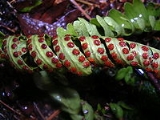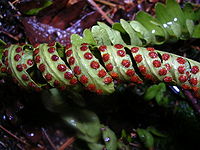
Sorus
Encyclopedia


Sporangium
A sporangium is an enclosure in which spores are formed. It can be composed of a single cell or can be multicellular. All plants, fungi, and many other lineages form sporangia at some point in their life cycle...
(structures producing and containing spore
Spore
In biology, a spore is a reproductive structure that is adapted for dispersal and surviving for extended periods of time in unfavorable conditions. Spores form part of the life cycles of many bacteria, plants, algae, fungi and some protozoa. According to scientist Dr...
s).
In fungi and lichens, the sorus is surrounded by an external layer. In some red algae it may take the form of a depression into the thallus.
In ferns, these form a yellowish or brownish mass on the edge or underside of a fertile frond
Frond
The term frond refers to a large, divided leaf. In both common usage and botanical nomenclature, the leaves of ferns are referred to as fronds and some botanists restrict the term to this group...
. In some species, they are protected during development by a scale or film of tissue called the indusium, which forms an umbrella-like cover.
Sori occur on the sporophyte
Sporophyte
All land plants, and some algae, have life cycles in which a haploid gametophyte generation alternates with a diploid sporophyte, the generation of a plant or algae that has a double set of chromosomes. A multicellular sporophyte generation or phase is present in the life cycle of all land plants...
generation, the sporangia within producing haploid meiospore
Spore
In biology, a spore is a reproductive structure that is adapted for dispersal and surviving for extended periods of time in unfavorable conditions. Spores form part of the life cycles of many bacteria, plants, algae, fungi and some protozoa. According to scientist Dr...
s. As the sporongia mature, the indusium shrivels so that spore release is unimpeded. The sporangia then burst and release the spores.
The shape, arrangement, and location of the sori are often valuable clues in the identification of fern taxa. Sori may be circular or linear. They may be arranged in rows, either parallel or oblique to the costa, or randomly. Their location may be marginal or set away from the margin on the frond lamina. The presence or absence of indusium is also used to identify fern taxa.

